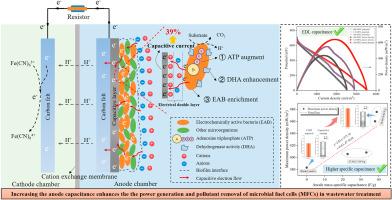提高阳极本征电容可以提高微生物燃料电池在污水处理中的性能
IF 8.4
2区 环境科学与生态学
Q1 ENVIRONMENTAL SCIENCES
引用次数: 0
摘要
电容阳极有望提高微生物燃料电池(mfc)在废水处理中的性能,但不同电容类型和质量比电容的电容阳极对性能的影响尚不清楚。本研究比较了双电层(EDL)和伪电容阳极,评价了它们在mfc中的发电和污染物去除效果。结果表明,负载2 mg质量的EDL阳极的比电容(27.95±7.39 F/g)是伪电容阳极(5.10±1.48 F/g)的5.48倍,最大功率密度(Pmax)为561.09±109.54 mW/m2。增加EDL质量负载进一步放大了电容电流贡献(39%)、Pmax和存储电荷。虽然对磺胺甲恶唑(SMX)(一种持久性有机污染物)的去除效果不明显,但在电容阳极的mfc中,COD的去除效果有所提高。负荷量为6mg的EDL阳极具有较好的综合发电性能和COD去除率(80%)。基于Pearson相关分析和微生物共生网络,揭示了电容阳极通过增加电容电流、增加电化学活性菌(EAB)丰度、增加三磷酸腺苷(ATP)含量和脱氢酶(DHA)活性来提高mfc发电量的机理。这些研究结果表明,提高阳极固有电容,特别是EDL电容,可以显著提高mfc的性能。本研究不仅为mfc的电极设计提供了新的方向,也将推动mfc作为集发电和储能于一体的双功能装置在污水处理中的发展。本文章由计算机程序翻译,如有差异,请以英文原文为准。

Enhancing anode intrinsic capacitance improves the performance of microbial fuel cells in wastewater treatment
Capacitive anodes hold promise for enhancing microbial fuel cells (MFCs) in wastewater treatment, yet the impact of capacitive anodes with different capacitance type and mass specific capacitance on the performance remains unclear. This study compared electric double layer (EDL) and pseudo-capacitance anodes, evaluating their power generation and pollutant removal in MFCs. Results showed that EDL anode with 2 mg mass loading achieved 5.48-fold higher specific capacitance (27.95 ± 7.39 F/g) than pseudo-capacitance anodes (5.10 ± 1.48 F/g), enabling a higher maximum power density (Pmax) of 561.09 ± 109.54 mW/m2. Increasing EDL mass loading further amplified capacitive current contributions (39 %), Pmax and stored charge. Although there was no obvious effect on sulfamethoxazole (SMX) (a persistent organic pollutant) removal, COD removal was improved in MFCs with capacitive anodes. EDL anode with 6 mg mass loading had satisfactory comprehensive performance of power generation and COD removal (>80 %). Based on Pearson correlation analysis and microbial co-occurrence networks, the mechanism of capacitive anodes to enhance MFCs power generation by increasing capacitive current, electrochemically active bacteria (EAB) abundance, and adenosine triphosphate (ATP) content and dehydrogenase activity (DHA) was revealed. These findings demonstrate that enhancing the anode intrinsic capacitance, particularly EDL capacitance, can significantly improve MFCs performance. This study will not only provide a new direction for the electrode design of MFCs, but also advance the development of MFCs as dual-functional devices integrating power generation and energy storage capabilities in wastewater treatment.
求助全文
通过发布文献求助,成功后即可免费获取论文全文。
去求助
来源期刊

Journal of Environmental Management
环境科学-环境科学
CiteScore
13.70
自引率
5.70%
发文量
2477
审稿时长
84 days
期刊介绍:
The Journal of Environmental Management is a journal for the publication of peer reviewed, original research for all aspects of management and the managed use of the environment, both natural and man-made.Critical review articles are also welcome; submission of these is strongly encouraged.
 求助内容:
求助内容: 应助结果提醒方式:
应助结果提醒方式:


